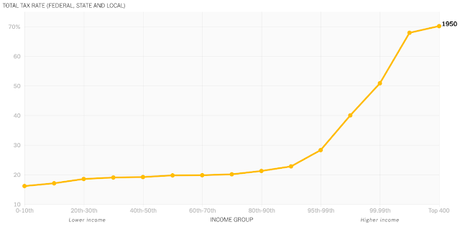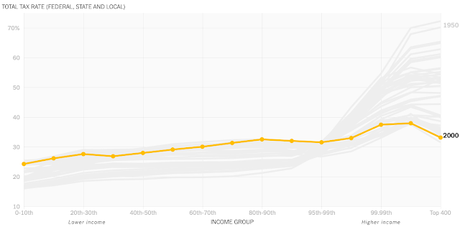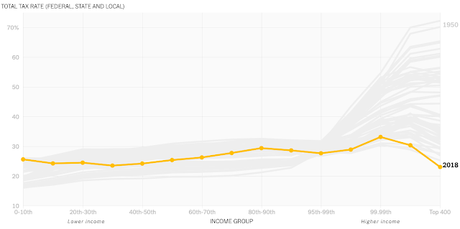



The charts above are from The New York Times. They show the total tax rate paid by all income groups in this country (total of federal, state, and local taxes). The United States has traditionally had a progressive tax system. That means that those who make more money pay a higher tax rate than those who make less. Republicans (whose main constituency is the rich) don't like progressive taxation.
Note in the top chart, the progressive taxation was working in 1950. As income rose, so did the total tax rate, and for the rich that rate was substantially higher than for other groups (about 70%). Republicans will tell you that inhabits growth and hurts the economy, but the 1950's was actually a booming economy for the United States.
About 1980, the Republicans gained control of the government, and they immediately began to lower the taxes for the rich (mainly the top 5%). The administrations of Reagan, Bush II, and Trump substantially lowered the tax burden on the rich, while leaving the tax burden on everyone else about the same as it was. The result is shown in the bottom chart. Now it is a fact the the richest Americans actually pay a smaller percentage of their income (smaller tax rate) than any other group in the country (including the poor).
The Republicans told us this would grow the economy and increase wage for everyone. That has not happened. All it has done is fatten the bank accounts of the rich and balloon the deficit and national debt of our federal government.
Here's is part of an excellent article by David Leonhardt in The New York Times on this:
Almost a decade ago, Warren Buffett made a claim that would become famous. He said that he paid a lower tax rate than his secretary, thanks to the many loopholes and deductions that benefit the wealthy. His claim sparked a debate about the fairness of the tax system. In the end, the expert consensus was that, whatever Buffett’s specific situation, most wealthy Americans did not actually pay a lower tax rate than the middle class. “Is it the norm?” the fact-checking outfit Politifact asked. “No.” Time for an update: It’s the norm now. For the first time on record, the 400 wealthiest Americans last year paid a lower total tax rate — spanning federal, state and local taxes — than any other income group, according to newly released data. The overall tax rate on the richest 400 households last year was only 23 percent, meaning that their combined tax payments equaled less than one quarter of their total income. This overall rate was 70 percent in 1950 and 47 percent in 1980. For middle-class and poor families, the picture is different. Federal income taxes have also declined modestly for these families, but they haven’t benefited much if at all from the decline in the corporate tax or estate tax. And they now pay more in payroll taxes (which finance Medicare and Social Security) than in the past. Over all, their taxes have remained fairly flat. The combined result is that over the last 75 years the United States tax system has become radically less progressive. The data here come from the most important book on government policy that I’ve read in a long time — called “The Triumph of Injustice,” to be released next week. The authors are Emmanuel Saez and Gabriel Zucman, both professors at the University of California, Berkeley, who have done pathbreaking work on taxes. Saez has won the award that goes to the top academic economist under age 40, and Zucman was recently profiled on the cover of Bloomberg BusinessWeek magazine as “the wealth detective.” They have constructed a historical database that tracks the tax payments of households at different points along the income spectrum going back to 1913, when the federal income tax began. The story they tell is maddening — and yet ultimately energizing. “Many people have the view that nothing can be done,” Zucman told me. “Our case is, ‘No, that’s wrong. Look at history.’” As they write in the book: “Societies can choose whatever level of tax progressivity they want.” When the United States has raised tax rates on the wealthy and made rigorous efforts to collect those taxes, it has succeeded in doing so. And it can succeed again. . . . The American economy just doesn’t function very well when tax rates on the rich are low and inequality is sky high. It was true in the lead-up to the Great Depression, and it’s been true recently. Which means that raising high-end taxes isn’t about punishing the rich (who, by the way, will still be rich). It’s about creating an economy that works better for the vast majority of Americans. In their book, Saez and Zucman sketch out a modern progressive tax code. The overall tax rate on the richest 1 percent would roughly double, to about 60 percent. The tax increases would bring in about $750 billion a year, or 4 percent of G.D.P., enough to pay for universal pre-K, an infrastructure program, medical research, clean energy and more. Those are the kinds of policies that do lift economic growth. One crucial part of the agenda is a minimum global corporate taxof at least 25 percent. A company would have to pay the tax on its profits in the United States even if it set up headquarters in Ireland or Bermuda. Saez and Zucman also favor a wealth tax; Elizabeth Warren’s version is based on their work. And they call for the creation of a Public Protection Bureau, to help the I.R.S. crack down on tax dodging. I already know what some critics will say about these arguments — that the rich will always figure out a way to avoid taxes. That’s simply not the case. True, they will always manage to avoid some taxes. But history shows that serious attempts to collect more taxes usually succeed. Ask yourself this: If efforts to tax the super-rich were really doomed to fail, why would so many of the super-rich be fighting so hard to defeat those efforts?

